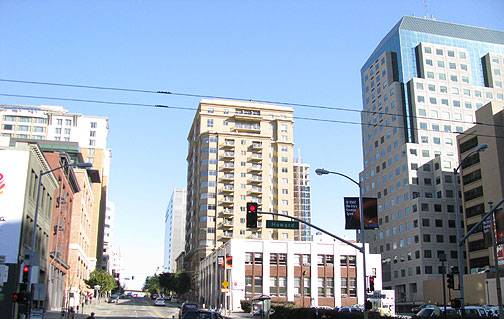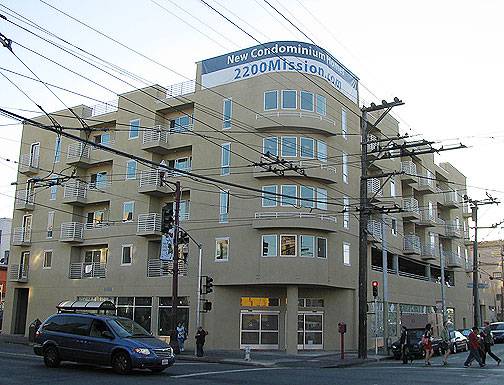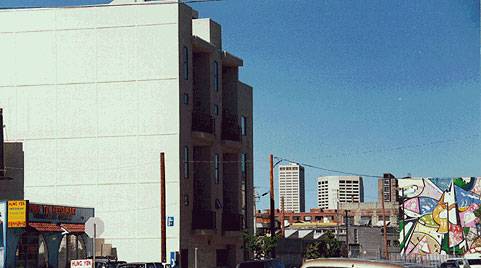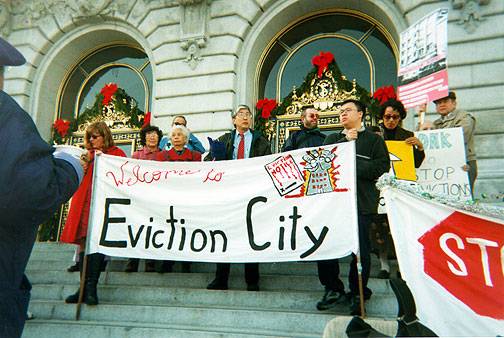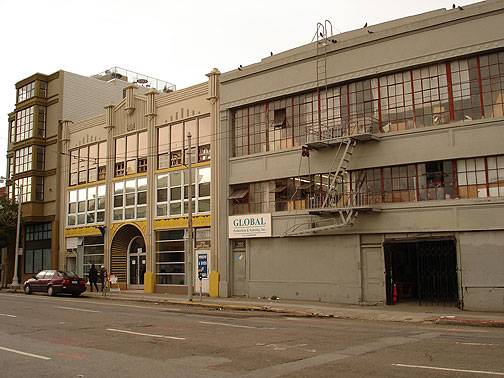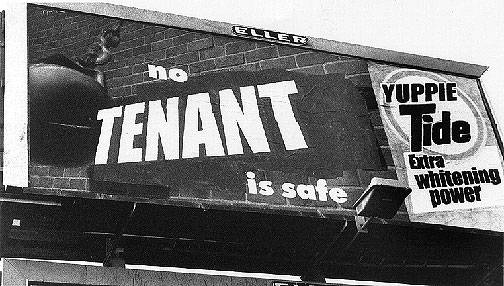McFrisco
Historical Essay
by Quintin Mecke
New condominiums on Rincon Hill above 2nd and Howard, 2008.
Photo: Chris Carlsson
New condos at 18th and Mission, 2008.
Photo: Chris Carlsson
The effects of Mayor Willie L. Brown Jr.’s land-use policies will be felt for generations. Due to his fast-food approach to land-use planning, production, convenience, and conformity reigned over a “balanced and healthy” planning diet. As a result, the city became increasingly obese, with high-end developments that only served the upper class and privileged, with working-class people being forced out of their workplaces and homes. Brown’s answer? “If you don’t make $50,000 a year in San Francisco, then you shouldn’t live here,” he said on national television. It was the most direct assault on the demographic soul of this city since the 1960s era of redevelopment and Justin Hermann. Reshaping the city in his own inflated self-image gave Willie the moniker “da Mayor,” but gave the city big-ticket developments that will wreak havoc on the quality of life in years to come.
A noted sociologist, George Rizner, coined the phrase “McDonaldization” in the 1990s, which for him represented a “process by which the principles of the fast-food restaurant are coming to dominate more and more sectors of American society as well as the rest of the world.” Historically, development issues have often divided San Franciscans, but the transformation during Mayor Brown’s administration of what was once the Department of City Planning into a Department of Development Facilitation stunned even the most jaded observers. It quickly began to resemble the famed golden arches—new projects were approved as fast as developers could propose them. For example, from 1997 to 2001, during the height of the dot.com boom, the Planning Commission of the City and County of San Francisco approved over 2,500 live-work units throughout the city, the vast majority in neighborhoods like the South of Market, Mission, and Potrero Hill. This does not include the vast number of dot.com offices that were placed throughout the city in areas not zoned for office use. During that same period, not one proposed live-work project was ever rejected, a record so frighteningly perfect that to this day it can make any sane planner still working for the Planning Department cringe when it’s mentioned. That was a time when San Francisco reveled in being a hip playground for the up-and-coming. It was also a time when San Francisco’s McDonaldization was at its peak, simplifying and commodifying the elements that make our city unique, and packaging them for consumption.
New lofts on Harrison and 18th, 1999.
Photo: Chris Carlsson
With its inaccessible lexicon of phrases, terms, and concepts, the language and discourse of land-use planning represents the epitome of Michel Foucault’s belief that not only is knowledge power, but that power is at its strongest (and most invisible) in the simple structures of language. Terms like “conditional use,” “discretionary review,” “PDR,” and ‘nonconforming use’ are the everyday tools that shape and mold our neighborhoods. They are found within the planning code, the bible of land use, and if you don’t know what they mean, then you are not alone.
But when plans threaten to demolish or radically alter your neighborhood, time is of the essence and you will have just weeks to learn these terms. Just imagine a new project is being proposed in your neighborhood and you happen to be one of the lucky neighbors within 300 feet who is deemed worthy of a public notice by the Planning Department. On the off chance that you actually read the posted notice on your way to the coffee shop, were able to vaguely decipher it, and found yourself masochistic enough to follow your curiosity, you now have made your first step into the world of land use, and quickly down the rabbit hole you will go.
In this world where language is power, there is no greater example of the power behind two words than “conditional use.” “Conditional use” is the term used to define the idea that the use being proposed is not allowed “as of right” and will only be permitted with “conditions.” Depending on the size of the project, these conditions can include specific hours for delivery of goods, parking limitations, pedestrian safety measures, noise restrictions, and affordable housing units. For activists, “conditional use” represents the stone in David’s sling relative to a neighborhood’s power to fight or alter a proposed project, and it guarantees a hearing at City Hall in front of the Planning Commission, which will decide whether to grant the permit. This is not to say that neighbors or activists win every conditional-use permit hearing, but it does mean that there is at least a chance to do so, and importantly that there will be a dialogue about it.
Deploying this language are the translators and native speakers, the real players and dealmakers who are found every Thursday in City Hall’s room 400 for the weekly meetings of the Planning Commission. Within that room social engineering is allowed by law and is driven by language that reinforces and strengthens our society’s historical divisions of race, class, and gender. The typical San Franciscan doesn’t realize that, of the numerous issues that people here argue about, only a few issues truly have the power to fundamentally affect who and who does not live here. For those in the loop, land-use planning and zoning decisions represent the most effective way of encouraging and—more important—discouraging certain types of people. Not only is zoning used to dictate what uses will be permitted, it also determines economically who and who may not live in a given area. While the idea of social engineering may conjure up strong images of a Brave New World future society for some, this is the heart of land-use planning and a stark reality. The decisions of who will live in San Francisco are made by a select few who can use and manipulate this complex system of specialized and coded language. Only by learning and explaining it will activists and neighbors be able to expose the wizards behind the curtain who determine the shape of our city with their weekly planning decisions.
Aside from language, the other obstacle to challenging the dynamic of land-use planning is an institutional one. Until the passage in March 2002 of Proposition D, the mayor had complete control of appointments to the Planning Commission and also appointed the head of the Planning Department. This gave him enormous political power and that power was used without pause or regret. Upon assuming office in 1996 and with the economy of the Bay Area growing steadily, Brown (who had extremely close ties with developers during his career in Sacramento) made land use his signature priority. And with his appointment of then midlevel planner Gerald Green as director, the Planning Department shifted from land-use planning to development facilitation. Unfortunately for the city, Brown’s tenure happened to coincide with the largest influx of capital into San Francisco since the Gold Rush. Another great battle for the city had begun.
Those most directly affected were slow to react at first, as they tried to come to terms with the magnitude of what was happening. With his “build it and they will come” mantra, Brown made it absolutely clear that no dissension from his plan was to be tolerated (portending Bush’s “you’re either with us or against us”). Significant public casualties foreshadowed the political struggle that was to come, and left no doubt about who was in charge and how Brown would deal with dissent. In December 1999, the then-zoning administrator of the Planning Department, Mary Gallagher, ruled that all of the roughly 177 antennae on the Sutro Tower atop Twin Peaks (owned by the major media outlets) did not have the necessary permits. She ruled that they would all need new conditional-use permits, sustaining the concerns of the surrounding neighbors. However, within days of her decision, she was relieved of her duties as zoning administrator and her decision was reversed by Director Green. One of the first public shots across the bow had been fired.
The second came in September 2000 when Brown fired longtime planning commissioner Dennis Antenore because he refused to support Proposition K, the mayor’s pro-development ballot initiative. In a letter to Antenore, Brown told him that “this issue is simply too important for there to be disagreement at the highest level of government,” and with that, he was gone.
Resistance at this point began to gather steam. Neighborhoods that were late to catch on began to muster coalitions for an effective counterattack. In 2000, I was a community organizer in the South of Market, and a virgin to the world of land use. However, as I watched longtime small businesses, nonprofits, and artists forced out by higher rents due to bad planning decisions, necessity drove me and many others in the neighborhood to take action. We took our cues from better organized neighborhoods like the Mission and organized the South of Market Anti-Displacement Coalition, also known as SOMAD. (Of course, given what we were facing, SOMAD could have easily been known as SO-STUNNED or SO-PISSED but then our catchy acronym wouldn’t have worked.) We tried to stop the flood of live-work projects and dot.com offices that were moving in faster than we could protest against them. Over the course of the following months, we organized protests at the Planning Commission, held rallies at City Hall, and tried desperately to direct the media’s attention toward what was happening.
Anti-eviction demonstration, City Hall, 1999.
Photo: Chris Carlsson
By the summer of 2000, the battle took on a fevered pitch and the media began to cover the stories more regularly. In June the neighborhood protests grew louder and developers called for decreasing the limitations on new commercial office buildings. Brown held a meeting at City Hall with members of the Chamber of Commerce, SPUR, and other groups to see what changes could be made to 1986’s Proposition M, which had created annual limits on office-space development in the last major land-use battle. The meeting ended without agreement, but it spawned the framework for Proposition L, a ballot initiative favored by neighborhood activists and community groups that limited new office development in parts of the Mission, South of Market, and Potrero Hill districts, while also redefining the controversial live-work lofts as residential units, subject to infrastructure fees for transportation, schools, and affordable housing. Support for Proposition L quickly became the dividing line between whether you were a friend or foe of Mayor Brown. With the return of district elections in November 2000, land use had now become the single defining issue and it eventually led to a slate of “progressive” supervisors being elected. After suffering from years of Brown’s cronyism and McPlanning, this was the political change that activists had been waiting for. The initial shock of our political victory in the fall of 2000 lasted well into 2001 and the first months after the election represented the best days of SOMAD’s existence. We had regular well-attended meetings and, in Chris Daly, a voice who listened to us in City Hall. It felt as if we had some power.
Slowly, however, things started to settle down into routine politics. Differences among groups that were glossed over during the campaign began to emerge again. Once united in their opposition to Brown, neighborhoods began to reclaim their individual identities around the issues that were important to them. On the land-use front, issues of race and class began to emerge again, as the reality of the work that lay ahead of us became clear. We were left with the daunting task of empowering and enabling residents to participate in a game that was fundamentally stacked against them. Quickly it became clear to me that SOMAD, as a volunteer grassroots coalition, was not up to this task. We had a few individuals who could speak the language of land use, but they did not have the ability, time, or patience to transfer and pass this knowledge onto others. Add to that the fact that with the new Board of Supervisors and the sudden crash of the economy, many people believed that the danger had passed. There seemed no longer a need for them to participate, and they felt free from the obligation of doing the less dramatic and more grueling work of developing our community’s resources.
New loft sits alongside two warehouses on Howard at Langton Alley. The warehouses are sinking into the marsh that still sits beneath this part of South of Market, and it will be interesting to see how many of the dozens of loft projects approved by the Brown administration survive the next big earthquake (many were built for the quick profit, with poor foundations and little thought to the subsidence that characterizes this part of town).
Photo and caption: Chris Carlsson
The neighborhood dynamic shifted from active resistance to solution creation, and our relevance and influence waned when we couldn’t break out of being SOMAD to become SOABLE. Other groups began to form, such as the South of Market Community Action Network, that were more adapted to the new landscape. Additionally, SOMAD discovered in itself the same divisions of race, class, and gender that we had projected onto the dot.com businesses. We were slow to realize this, but once we did, it was clear to me that SOMAD’s days were numbered. We managed to hold things together until early 2003, primarily because our name still had some minor political influence—always hard to acquire. SOMAD did manage in a brief period of time to become an established player in the world of land use, but in the end, we too McDonaldized community development in that we tried to be a quick fix to a problem that actually required a long-term diet of investment, organizing, and empowerment.
Even with SOMAD’s limitations, good work did come out of this tumultuous time and healthier options did arise. In the Mission, MAC (Mission Anti-Displacement Coalition) was able to gain substantial funding and succeeded in organizing the neighborhood, later guiding it through a rezoning process. This represented a hopeful example to other activist groups that it was possible to lead not only by being against something but to also be for an idea as well. In the South of Market, a commercial printer by the name of Jim Meko recognized the desperate need for dialogue regarding land use and took on the responsibility of convening people from all over the neighborhood once a month to discuss land use, planning, and rezoning. The response was better than expected, and the forum has now become a regular venue for residents to vet their concerns and hear new updates about what is planned for the area. On an individual level, because of his persistence and knowledge, Meko has also cultivated important relationships with planners, developers, and commissioners. He has now become a political force large enough to ensure that residents have an opportunity to be heard and consulted before attempts are made to further McFrisco the neighborhood.
California Dept. of Corrections' altered billboard, 1990s.
What I didn’t realize at the time is that the change for which we had fought so hard and long was only an illusion. Despite our political efforts, we found no Rosetta Stone making the language of land use planning suddenly accessible to thousands. The Planning Commission continued with its weekly meetings and Gerald Green continued as director. Room 400 was still packed with land-use attorneys every Thursday. The local election results of 2000 were satisfying on the surface, but I began to see that the game itself had not changed, nor had the institutions and power that shape it. We had substituted different players who supported our positions, but the rules and referees were the same. (It reminded me of the first presidential election that I was eligible to vote in, in 1992. I had somehow survived a Republican upbringing, and Clinton’s victory made me believe that the world had shifted. But then the inaugural chords of “Don’t Stop Thinking about Tomorrow” faded into typical political gamesmanship.) We want to believe that change can come quickly. That is the ultimate tease and temptation of political campaigns, especially candidate-driven ones. We transfer collective power onto an individual who we believe will rise above his or her own humanity and change our lives. All we have to do is pull the lever.
This cult of personality was never more evident than in the recent mayoral election between Gavin Newsom and Matt Gonzalez, with supporters from both sides projecting values and qualities onto the candidates that expanded them beyond normal human boundaries. As one of the original campaign workers on the Gonzalez campaign, I can remember sitting with the campaign manager in the cramped Horseshoe Café in the Lower Haight in early August, thinking to myself, “What in god’s name are we doing?” And no sooner had I said that than we were in the December runoff. Yet despite the energy, new relationships, and successful efforts that developed during that campaign, I still feel empty. Once again, instead of developing our community, instead of investing in the long and tiresome work of grassroots organizing, of empowering our neighborhoods, we allowed ourselves to fall into the predictable dead-end of a political campaign as our preferred method of change.
What became of all that energy, excitement, and talk of a movement after the campaign ended? It was quickly deflated as the chosen progressive vessel, Matt Gonzalez, bowed out of public life only months after proclaiming that he, or rather he-representing-us, would act as loyal opposition to the Newsom administration when needed. And with that simple decision, the Left was presented with a self-reflective, scathing critique of why communities need to invest in themselves and not in politicians. In the end they will stay while the politicians come and go. I felt especially burned because we had learned this lesson in countless previous election cycles, and specifically after the 2000 elections.
I will not miss the San Francisco of Mayor Brown, but I know that unless we learn the lessons from what happened during his tenure, we will be faced with a similar situation in years to come. I have often thought of wisdom as the ability to learn something without having to directly experience it, a talent based on observation and intuition rather than visceral reaction. Now, having experienced Mayor Brown and the disappointment of winning political campaigns, I want to discover new alternatives to old paradigms. As a result, I do not hope for a utopian solution to fundamentally alter the framework of land use. But I do believe that we can change the menu and the process behind it and we have examples of the recipes that can work. Both MAC and Jim Meko represent exactly the type of home-cooked alternatives that can begin to provide better fare than the developer-led, politician-facilitated, and genetically modified meals cooked up under Brown and current director Green.
To advance this, our neighborhoods must reclaim our forgotten power. We will not succeed with a singular focus on electoral politics as a means for change. How we use our land is a direct reflection of our values, and as such, is worth fighting for. With these ingredients we can build the foundation of a healthier existence and gain the wisdom that has eluded us so far. A community realizes its potential only through a balanced program of organizing and empowerment. If we continue to fall for the temptation of exclusively channeling our limited energy into electoral politics, then we will be as guilty as Willie Brown of McDonaldizing the city.
San Francisco is not alone in this fight against cultural homogenization; it is a battle that it is taking place across the globe as people have begun to recognize the growing threat of McDonaldization to all aspects of our lives. Taking our cue from French farmers like José Bové, who has led direct- action campaigns against McDonald’s and corporate agribusiness, we can find inspiration to stand up to the golden arches of convenience that are deemed as progress. Here at home, we know that there are countless José Bovés among us and it is time to empower and encourage them to continue struggling for a genuine community, a life worthy of we the living; a life worthy of San Francisco.
File:Redevelopment-tour-button.jpg return to beginning of Redevelopment tour
published originally in The Political Edge ed. Chris Carlsson (City Lights Foundation: 2004)

